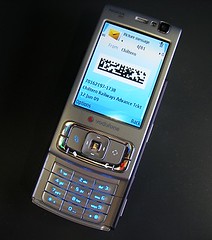 For me, the capital is about 90 minutes away by train. Chiltern Railways provide a nice efficient service and also sell "e-tickets". My plan involved killing two birds with one stone and trying out one of these as well as getting a cheap trip. An e- ticket has to be bought on-line in advance. The "ticket" is then texted to your mobile 'phone as a picture of a bar code. No trees are harmed in the production of this ticket. To be honest, once these arrived I wasn't entirely convinced that this would work but maybe this technology stuff will catch on one day.
For me, the capital is about 90 minutes away by train. Chiltern Railways provide a nice efficient service and also sell "e-tickets". My plan involved killing two birds with one stone and trying out one of these as well as getting a cheap trip. An e- ticket has to be bought on-line in advance. The "ticket" is then texted to your mobile 'phone as a picture of a bar code. No trees are harmed in the production of this ticket. To be honest, once these arrived I wasn't entirely convinced that this would work but maybe this technology stuff will catch on one day.From the guide I picked a couple of secret objects to visit: The smallest Police station in Trafalgar Square and Samuel Gurney's drinking fountain in Holburn. To this I added one of my own, the prototype red telephone box at Burlington House. According to the map these were walkable in the time available and would allow me to travel through places I'd never been.
At Leamington station the ticket barrier monitor didn't look at me stupid when I showed him my phone - he just opened the barriers for me (as an aside, where is the saving if you have to employ someone to man the automatic barriers) and I wandered up the the platform. With all the efficiency you'd hope for, my train arrived and just before lunchtime I was in the big smoke. Price to get there - a tenner.
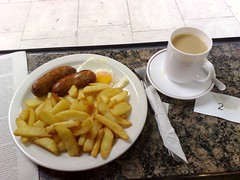 Normally I make an effort to get in to "town" early to get the most out of the day. Buying cheap tickets limits this a lot during the week as Chiltern can fill all the commuter trains they like with people paying full fare and so have no desire to make things easy for the plebs wanting to play tourist. The benefit of a lunchtime(ish) arrival was that I managed to tick off another London thing - sausage, egg & chips at the cafe opposite Marylebone station. London cafs are great and for £2.95 I had 2 sausages, egg and chips. Tea in a mug and a cookie (to eat while wandering around) brought the total to just over the fiver. Excellent value and very delicious thank you very much. Just the thing to set you up for a good stroll. And I took a picture since it seems everyone likes photos of food judging by the response to a recent shot of some Yorkshire pud I posted once.
Normally I make an effort to get in to "town" early to get the most out of the day. Buying cheap tickets limits this a lot during the week as Chiltern can fill all the commuter trains they like with people paying full fare and so have no desire to make things easy for the plebs wanting to play tourist. The benefit of a lunchtime(ish) arrival was that I managed to tick off another London thing - sausage, egg & chips at the cafe opposite Marylebone station. London cafs are great and for £2.95 I had 2 sausages, egg and chips. Tea in a mug and a cookie (to eat while wandering around) brought the total to just over the fiver. Excellent value and very delicious thank you very much. Just the thing to set you up for a good stroll. And I took a picture since it seems everyone likes photos of food judging by the response to a recent shot of some Yorkshire pud I posted once.The first destination was Burlington Arcade, first introduced to me by AA Milne in his delightful 1920 collection of essays, "If I may". Milne used the arcade as a place to shelter from the rain before a lunch appointment. He describes the vendors as offering choices between regimental colour pajamas and strings of beads.
 Nowadays things have changed little. The pajamas are probably still available but mostly the gentleman is presented with a selection of cashmere sweaters and brogues. The former seem to me to be like normal jumpers, just rather more expensive. One even looked just like the sort of thing a granny might present you with at Christmas - the chest was a picture of a yacht deck with the sleeves in a gaudy blue and yellow. Yours sir, for a shade under 600 quid. Yes really.
Nowadays things have changed little. The pajamas are probably still available but mostly the gentleman is presented with a selection of cashmere sweaters and brogues. The former seem to me to be like normal jumpers, just rather more expensive. One even looked just like the sort of thing a granny might present you with at Christmas - the chest was a picture of a yacht deck with the sleeves in a gaudy blue and yellow. Yours sir, for a shade under 600 quid. Yes really.The jewelers fared a little better. Perhaps the London Jewelry week promotions, the arcade was carpeted with a red rug decorated with crystal designs, we helping move some stock but not much. Inside one shop the laptop on the counter was set to the Windows Vista game section of the programs screen. Someone was presumably having a lot of Patience while they waited to sell a Solitaire...
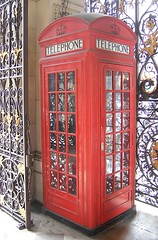 A couple of doors down was my first objective, Burlington House. In the entrance archway there are two traditional London telephone boxes, K2's for the cognoscente. The one on the right is extra special. Thanks to John Timpson's book "Requiem for a Red Box" I know that this is the prototype for this archetypal British building designed by Sir Giles Gilbery Scott. A small British Telecom plaque inside tells the visitor that this was the original, as does tapping on the sides - it's made of wood rather than the cast iron of production versions.
A couple of doors down was my first objective, Burlington House. In the entrance archway there are two traditional London telephone boxes, K2's for the cognoscente. The one on the right is extra special. Thanks to John Timpson's book "Requiem for a Red Box" I know that this is the prototype for this archetypal British building designed by Sir Giles Gilbery Scott. A small British Telecom plaque inside tells the visitor that this was the original, as does tapping on the sides - it's made of wood rather than the cast iron of production versions.Of course most people ignore the box - London is littered with them as well as the later and slightly smaller K6 versions - they are heading for the art gallery inside. By accident I had happened upon the Summer Exhibition. This is when 10,000 artworks are submitted by absolutely anyone and 1000 are chosen for display. It's an annual event that often appears on TV with some presenter trying to get their daub through the judging process and on to the wall. I've never been so in the spirit of adventure, I paid my 7 quid and went in.
I don't know much about art, but I know what I like (who said that, oh, me just now). What I know is that on that basis, an awful lot of this was rubbish. And quite badly displayed. For example, the Small Western room is a small side gallery, the walls of which are covered in pictures. Many of these are wonderful small pictures but are displayed 10 feet above the ground. How are you supposed to appreciate them from the floor ?
Other rooms feature larger works with much more space around them. Perhaps my favorite showed off architects models on black shelving. Again, the person "hanging" these ought to realise we don't all come on stilts and if it's too high off the ground we can't see through the shelf either. Some nice stuff though and I appreciate the skill involved in making the models. One point, those who are comissioning the new Newport Station might want to do a quick search on "Ladies reproductive organs" before approving the model that was on display. You will thank me for that advice.
Having said that, the sheer variety of work on display meant there is something for everyone. Postcard from Heaven was simple enough, the back of a postcard asking the judging panel to put this in the exhibition because her mum would be so proud. Winter Allotments was another joy, a slightly cartoonish painting of a man on his allotment surrounded by plants and other horticultural stuff. It was one of those pictures you could look at again and again and see something new each time. Sadly even if I could have afforded it, the painting had sold by the time I visited, as had much of the art on display.
Exiting the main exhibition, via the room with video art (all video art is shite by the way so I won't bore you with it) and pausing only to discover that the meagre selection of postcards in the shop didn't include any of the works I'd liked, I wandered across the stairs to the free, fine art part of the hall. Here, in incredibly ornate rooms, were some of the most serious and dull oil paintings you can find, However, even here I learnt something. I am an Aestheticist. Basically I take my art at face value and consider that if something has to be explained to me, it's probably rubbish. Actually this isn't entirely true, I can appreciate the workmanship in producing something too but if it's badly made and looks a mess then it can go in a skip rather than a gallery. This will not endear me to the art world which prefers inaccessible toss.
Enough art however, I needed to be on my way but outside Burlington House was another distraction - Fortnum & Mason. For those not familiar with the name, it's a posh grocer. They still display the Queen Mother's crest proudly although I wonder if someone ought tell them there is a reason she's not been in to pay her bill recently. This is one of those shops on the tourist trail along with Harrods and probably Hamleys. Inside is sumptuous and full of pricey stuff. I'd love to be the sort of person who considered this to be a handy local shop I nipped in to regularly for provisions, it's so wonderfully olde-worlde.
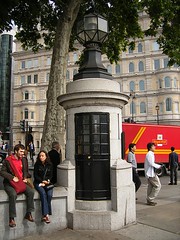 A short stroll led me to Trafalgar Square and my second objective - the world's smallest police station. Stone built with slit windows and surmounted by a lantern, this was apparently used to keep look out during political demonstrations and had a telephone hot line to Scotland Yard. This isn't as unusual as you might think, those famous police boxes a la Dr Who were also used for the same purpose. Some were even made large enough to house a temporary cell. Nowadays radios and squad cars have left the station as a cleaners cupboard.
A short stroll led me to Trafalgar Square and my second objective - the world's smallest police station. Stone built with slit windows and surmounted by a lantern, this was apparently used to keep look out during political demonstrations and had a telephone hot line to Scotland Yard. This isn't as unusual as you might think, those famous police boxes a la Dr Who were also used for the same purpose. Some were even made large enough to house a temporary cell. Nowadays radios and squad cars have left the station as a cleaners cupboard.Next stop was to be Holburn and this was reached via The Strand and a short stretch of Fleet Street. En route I took in such gems as Somerset House and the Royal Courts of justice. Tripping over locations like this so often makes you realise how small London really is. As a tube user you simply don't get the geography or the concentration of good things in such a small area.
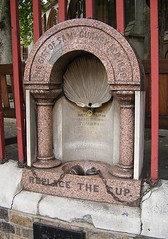 Gurney's fountain took a little finding but it's in the railing of St Sepulchre's church oppose the the Old Bailey. I'll admit I wouldn't fancy trying it, even if the water were working. The cups attached by chains my be nice an original but I feel hygiene may have been compromised in the 150 years since it was installed.
Gurney's fountain took a little finding but it's in the railing of St Sepulchre's church oppose the the Old Bailey. I'll admit I wouldn't fancy trying it, even if the water were working. The cups attached by chains my be nice an original but I feel hygiene may have been compromised in the 150 years since it was installed.Having completed my mission and still with several hours to kill before the return train I looked around and spotted sign - the Smithfield Market. Now I've heard of this but again, never been there. Smithfield is the last surviving wholesale market in London. Once upon a time Covent Garden used to be the place to go for fruit and veg and not a tourist attraction and there were others. Times change and only the meat trade still works in this way. Even they have had to make changes as you aren't allowed to hang carcases on hooks in the open air any more.
The first thing that strikes you, or at least me, is the sheer size of the place. It's enormous. Apparently during WW2 the market was evacuated as it was easy to spot from the air and the authorities didn't feel regular concentrations of people in such a good target was a good idea. Arriving mid afternoon, everything was pretty much shut down apart from a couple of people hosing down a stand hidden behind some thick plastic curtains. Even empty though, the hall was striking. Imagining, with the help of a photo display handily provided for tourists, a market in full swing wasn't difficult and it must have been some sight. Apparently all the work was helped by local pubs opening early in the morning to lubricate workers who had clocked on well before dawn.
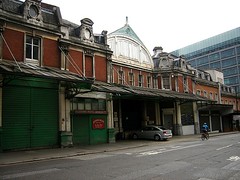
After this, my route is a bit of a blur. Trusting my sense of direction, and not being able to work out properly on my little map where I was I picked my way across the city heading in what I hoped was the right direction. Working on the basis that the Post Office Tower was too north and too west of where I wanted to be helped.
A couple of discoveries helped my trip. International Magic is a small shop but in the back of its dark interior you can buy magic tricks and have them demonstrated to you. A few doors down there is another business selling stainless steel screws...
All this walking made me peckish and by chance there was an "All you can eat" Thai Buffet. The food looked good and indeed the first plate was. Washing this down with some guava juice I headed up for a second dose, well you want to get value for money don't you, and it seemed the a switch had been thrown to make all the food taste less nice. Not nasty but just bad enough to stop the casual diner from eating all day. Do they all do this ? Is it just me ? If not, can this trick be patented - I foresee big sales in similar restaurants !
Last stop was Marylebone village. To me Marylebone is just the name of a station but it appears once upon a time this was a discrete area of the capital, probably in the days where there was hunting in Soho, and some marketing guru has decided that it would be profitable to keep the concept. Hence in a few days, there will be the Marylebone Village Fayre. Probably with maypoles and other rustic stuff. This is a reminder that London is home to around 7.5 million people, some of whom live in very nice little places indeed. Real communities exist so I suppose stores like Fortnum & Mason really are some peoples local shop.
As the sun set, crowds gathered outside pubs for traditional post work drinks. They spilled out over every pavement as the hot weather made sitting inside less appealing. Others relaxed with a cup of tea and puff on a hookah beside several cafes. Many hurried back to their last commute of the day gathering the free papers for entertainment on the journey. Even the half seven train was busy but with my £5 ticket scanned by the man on the gate I was assured of a seat through the countryside as my feet recovered a bit from the pounding. Why are London pavements so hard ?
I took some more pictures, go and have a look.



No comments:
Post a Comment